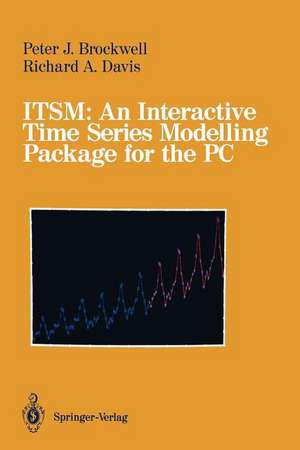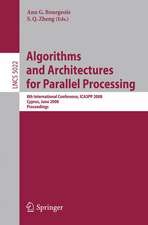ITSM: An Interactive Time Series Modelling Package for the PC
Autor Peter J. Brockwell R.J. Hyndman Autor Richard a. Davisen Limba Engleză Paperback – 5 mar 1991
| Toate formatele și edițiile | Preț | Express |
|---|---|---|
| Paperback (2) | 323.46 lei 6-8 săpt. | |
| Springer Berlin, Heidelberg – 1991 | 323.46 lei 6-8 săpt. | |
| Springer – 5 mar 1991 | 377.73 lei 6-8 săpt. |
Preț: 377.73 lei
Nou
Puncte Express: 567
Preț estimativ în valută:
72.30€ • 74.51$ • 61.04£
72.30€ • 74.51$ • 61.04£
Carte tipărită la comandă
Livrare economică 01-15 martie
Preluare comenzi: 021 569.72.76
Specificații
ISBN-13: 9780387974828
ISBN-10: 0387974822
Pagini: 104
Ilustrații: IX, 104 p. With online files/update.
Dimensiuni: 155 x 235 x 6 mm
Greutate: 0.17 kg
Ediția:Softcover reprint of the original 1st ed. 1991
Editura: Springer
Colecția Springer
Locul publicării:New York, NY, United States
ISBN-10: 0387974822
Pagini: 104
Ilustrații: IX, 104 p. With online files/update.
Dimensiuni: 155 x 235 x 6 mm
Greutate: 0.17 kg
Ediția:Softcover reprint of the original 1st ed. 1991
Editura: Springer
Colecția Springer
Locul publicării:New York, NY, United States
Public țintă
Professional/practitionerDescriere
Designed for the analysis of linear time series and the practical modelling and prediction of data collected sequentially in time. It provides the reader with a practical understanding of the six programs contained in the ITSM software (PEST, SPEC, SMOOTH, TRANS, ARVEC, and ARAR). This IBM compatible software is included in the back of the book on two 5 1/4'' diskettes and on one 3 1/2 '' diskette. - Easy to use menu system - Accessible to those with little or no previous compu- tational experience - Valuable to students in statistics, mathematics, busi- ness, engineering, and the natural and social sciences. This package is intended as a supplement to the text by the same authors, "Time Series: Theory and Methods." It can also be used in conjunction with most undergraduate and graduate texts on time series analysis.
Cuprins
1 Introduction.- 1.1 The Programs.- 1.2 System Requirements.- 1.2.1 Hard Disk Installation.- 1.3 Creating Data Files.- 2 PEST.- 2.1 Getting Started.- 2.1.1 Running PEST.- 2.1.2 PEST Tutorial.- 2.2 Preparing Your Data for Modelling.- 2.2.1 Entering Data.- 2.2.2 Filing Data.- 2.2.3 Plotting Data.- 2.2.4 Transforming Data.- 2.3 Finding a Model for Your Data.- 2.3.1 The ACF and PACF.- 2.3.2 Entering a Model.- 2.3.3 Preliminary Parameter Estimation.- 2.3.4 The AICC Statistic.- 2.3.5 Changing Your Model.- 2.3.6 Parameter Estimation; the Gaussian Likelihood.- 2.3.7 Optimization Results.- 2.4 Testing Your Model.- 2.4.1 Plotting the Residuals.- 2.4.2 ACF/PACF of the Residuals.- 2.4.3 Testing for Randomness of the Residuals.- 2.5 Prediction.- 2.5.1 Forecast Criteria.- 2.5.2 Forecast Results.- 2.5.3 Inverting Transformations.- 2.6 Model Properties.- 2.6.1 ARMA Models.- 2.6.2 Model ACF, PACF.- 2.6.3 Model Representations.- 2.6.4 Generating Realizations of a Random Series.- 2.6.5 Model Spectral Density.- 2.7 Nonparametric Spectral Estimation.- 2.7.1 Plotting the Periodogram.- 2.7.2 Plotting the Cumulative Periodogram.- 2.7.3 Fisher’s Test.- 2.7.4 Smoothing to Estimate the Spectral Density.- 3 SMOOTH.- 3.1 Introduction.- 3.2 Moving Average Smoothing.- 3.3 Exponential Smoothing.- 4 SPEC.- 4.1 Introduction.- 4.2 Bivariate Spectral Analysis.- 4.2.1 Estimating the Spectral Density of Each Series.- 4.2.2 Estimating the Absolute Coherency Spectrum.- 4.2.3 Estimating the Phase Spectrum.- 5 TRANS.- 5.1 Introduction.- 5.2 Computing Cross Correlations.- 5.3 An Overview of Transfer Function Modelling.- 5.4 Fitting a Preliminary Transfer Function Model.- 5.5 Calculating Residuals from a Transfer Function Model.- 5.6 LS Estimation and Prediction with Transfer Function Models.- 6 ARVEC.- 6.1 Introduction.- 6.1.1 Multivariate Autoregression.- 6.2 Model Selection with the AICC Criterion.- 6.3 Forecasting with the Fitted Model.- 7 ARAR.- 7.1 Introduction.- 7.1.1 Memory Shortening.- 7.1.2 Fitting a Subset Autoregression.- 7.2 Running the Program.- A Word6: A Screen Editor.- A.1 Basic Editing.- A.2 Alternate Keys.- A.3 Printing a File.- A.4 Merging Two or More Files.- A.5 Margins Left and Centre Justification.- A.6 Tab Settings.- A.7 Block Commands.- A.8 Searching.- A.9 Special Characters.- A.10 Function Keys.- A.11 Editing Information.- B Data Sets.














